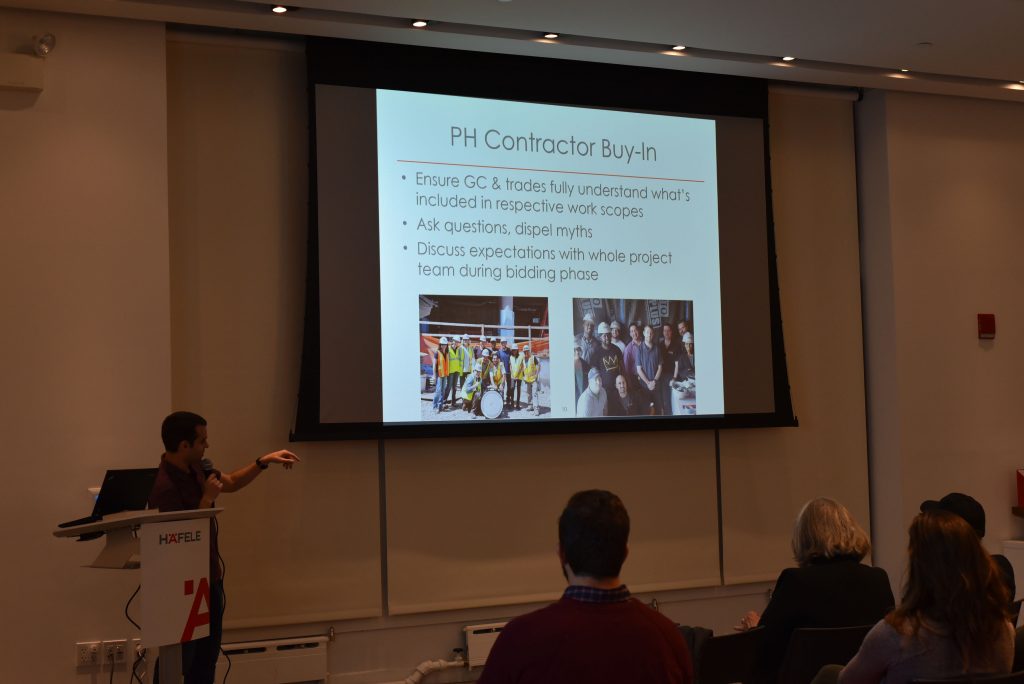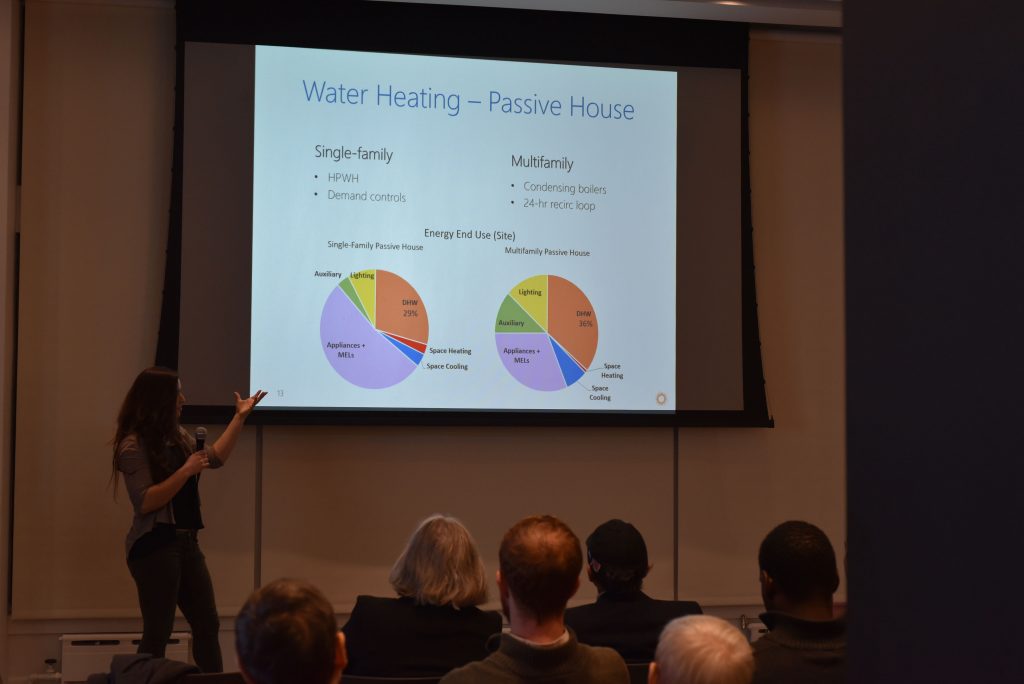By Jessica Bartolini; Photos by Olha Peralta
High-rise Passive House buildings were the subject of GreenHomeNYC’s monthly forum in October. The three presentations provided attendees with an overview of what implementing Passive House standards looks like in real life.
Gahl Sorkin Spanier of the Association for Energy Affordability (AEA) kicked off the evening with a presentation on how best to go about building a high-rise Passive House (PH) project. Kevin Brennan, formerly of AEA and now co-owner of Brennan Brennan Insulation and Air tightness, joined Gahl in sharing learnings from Passive House projects and training. AEA recently worked on an 86-unit PH affordable residence for seniors in Queens, in partnership with the non-profit organization HANAC.

Gahl emphasized the importance of holding training for the various trades building a PH project, noting that the main sources of air leakage are often at details where trade responsibilities are unclear. It is key, therefore, that training not only instill understanding of PH requirements, but also recognition of the importance of collaboration and coordinating across trades. Another takeaway from AEA’s experience is that training should not include more theory or math than necessary. Gahl noted that any general contractor personnel in a supervisory role should not only receive training, but also be empowered to teach others.
Regarding the timing of training, Gahl recommended avoiding scheduling it too long before the work actual commences, since people will forget some of the lessons and discussions. Scheduling training for when the maximum number of people are available, and the maximum number of trades are represented, will prove beneficial for the project. Training in inconvenient locations, or intensive time commitments–such as five consecutive full days–can also prove challenging.
Michael O’Donnell of Steven Winter Associates offered a presentation on inspecting and verifying multifamily PH construction. He noted that although the ground floor, top floor and roof maybe significantly different from single-family construction, the concepts are still similar to single-family, and many floors in between the ground floor and roof are usually repetitive. Mike said that a team of three to four staff is needed to inspect a multifamily building and handle tasks such as the blower door tests.
Mike used the Beach Green North project in Far Rockaway, Queens, as a case study. The 101-unit project is Passive House certified affordable housing. Although this project used insulated concrete form (ICF) construction, Mike noted that some PH projects are trying to do block and plank construction, and there are many ways to get to Passive House.

Mike’s presentation covered testing on mock-ups, which he noted can help create a lot of buy-in among the builders. Mike noted that the first window mock-up often fails testing, and advised against continuing with the verification/inspection without passing the window mock-up.
Mike echoed Gahl’s emphasis on the importance of training, and also advocated for advance planning with respect to the typical and unique checklists used in verification, as well as the blower door testing plan. One of Mike’s final recommendations was to not assume that subcontractors understand contract documents if there has not been explicit communication.
The evening’s final presentation was from Zoe Kaufman of Bright Power. Zoe emphasized the uniqueness of working with multifamily building stock in the Passive House realm: ownership structures,dominant loads, and centralized mechanical systems all make multifamily distinct from the single-family sector. The construction schedule and trades oversight, as well as standard construction methods, also differ across the two types of building stock. As heating and cooling loads shrink in all PH buildings, DHW energy usage becomes the main source of energy consumption in PH buildings.However, energy-efficient DHW technologies do not scale as easily as some other systems. While single-family PH homes bring down DHW loads with heat-pump water heaters and demand controls, large multifamily buildings tend to utilize condensing boilers serving 24-hour recirculation loops.

Zoe also discussed some high performance thermal insulation products that are emerging that could solve some space concerns unique to multifamily building. Phenolic foam core and vacuum-insulated panels, for instance, are super insulating, but the latter are problematic since their R-value plummets when subject to penetration—an almost unavoidable occurrence during construction. Indeed, later during Q&A Mike noted that since Cornell’s PH project employed panelized construction, there were around 2,700 penetrations to seal in the field.
Zoe’s presentation also discussed doors, windows, and skylights, noting that skylights are challenging, as there are currently only four PHI-certified skylight manufacturers, all of which are in Europe. When it comes to triple-pane windows, however, Zoe noted we are starting to see some made in the U.S. Zoe also made sure to recommend against sliding doors as they are particularly vulnerable to air leakage.

When, during Q&A, one attendee asked what the incentive is for developers to choose Passive House, it provided a great opportunity to sum up the evening. The panelists noted that Passive House’s greater quality of construction, reduced maintenance, energy savings of at least 40% compared to code, resiliency and occupant comfort all make Passive House an increasingly attractive option not only to mission-driven non-profit developers like HANAC, but to for-profit developers as well.
______________________________________________________________________________
